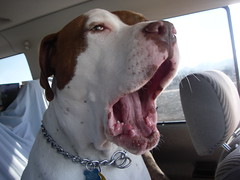
October 7th, 2009 I had an appointment with an orthopedic vet specialist to discuss Tucker’s present condition. Since relocating back to Southern California less than a month ago, Tucker has been exhibiting signs of lameness in his “good”, or non surgical, leg. This time I was not taking any chances. At the first signs his leg health was declining I scheduled an appointment with a specialist to discuss our options.
The surgical vet specialist with which we had our initial consultation spent almost 90 minutes with Tucker and I. He first examined his post-operative leg and we discussed all of the issues surrounding that repair. I told him about our experience with CM, why we chose a traditional repair, and his healing following the traditional repair. The veterinarian said that he could tell that Tucker’s leg did not fully heal, and his opinion was that most large dogs never do fully recover with a traditional repair. He said the major issue with any extracapsular technique is the fact that they rely on scar tissue to provide stability for the joint. In using the scar tissue to provide stability, you are losing range of motion in the joint, which is much more noticeable in larger breed dogs, like Tucker.
He suggested then that what we are seeing with Tucker is that he has only really started to use this (post surgical) leg when he injured his other one, and while the scar tissue resulting from the traditional repair has provided enough stability for the leg to be usable, it is nonetheless compromised. He reassured me that Tucker seems comfortable with his repaired leg, but warned me that he will have issues with arthritis and limited ROM (range of motion) due to the procedure that was done. He also mentioned that casting after surgery is not often a good idea, due to the fact that it can contribute to post-operative muscle wasting, making it hard for the dog to recover from surgery.
He went over the different options for Tucker – Tightrope, TTA, TPLO. He is a proponent of TPLO. As someone who has been performing CCL repair operations for 20 years, and he strongly feels that TPLO this is by far the best way to go with large breed dogs. He says that there is medical literature that suggests TPLO surgery can actually halt the onset and development of arthritis; reminding me again that Tucker would undoubtedly have issues with arthritis down the line because of his traditional repair.
I expressed concerns regarding keeping plates on his bones. The veterinarian met this objection by saying that anything done during any of the surgeries is a foreign material being introduced into the body – the lateral suture introduced leader line, the TR would introduce fibertape, and the tplo/tta would introduce metal. He said that if this was really a concern they could always go back in and remove the metal, but this would mean an additional procedure.

I then probed the vet about his feelings on the Tight Rope repair technique, and wanted to know if he had performed any of these procedures. He told me that he had done the procedure, and he felt that it was a more advanced form of the traditional extra capsular repair that Tucker had done in his left leg. He gave me a brief overview of the Tightrope procedure, mentioning that the type of material used would be the ultimate factor influencing the price of the TR surgery. He said that if I wanted to go with the most economical product I should go with the Fibertape alternative made by Securos; he had no preference either way. I then asked him if there had been any issue with injury or infection at the site where the bone tunnels were created. The vet did not answer this question directly, instead he explained to me that ortho fiber wire would be placed through tunnels, which are basically metal inserts to protect bone, allowing the fibertape to ease through the turns so it does not put so much strain on bone.
Final Vet Recommendations:
1) Glucosamine/Chondrointin Supplement
2) Omega 3 1200mg
3) Novox (Rimadyl or Carprofen) 75 mg Twice per Day
4) Lose Weight
5) Swimming
6) Schedule repair surgery ASAP – preferably TPLO
The veterinarian was great, and I really appreciated the time he spent answering my questions and giving me recommendations at the conclusion of the visit. He adequately addressed most of the concerns I raised about the different procedures, and was more than happy to have me lead the consultation with my seemingly endless array of information. If I wanted to have surgery done, I would definitely take my dog to him, but I just am not “sold” on the idea of having Tucker go through another costly and invasive procedure just to end up with a mediocre result.
And so begins a second round of Conservative Management… I am starting him today on Novox once per day, Omega 3 600 mg in the morning and in the evening, continuing his Glucosamine/Chondrointin/MSM supplement, and incorporating some light exercise into his routine to hopefully get some weight off and get his joints moving. Wish us luck, and I will be sure to keep you updated on our progress!
An Update: We were successfully able to use conservative techniques to “heal” Tucker’s second torn cruciate ligament.
Read all about our CM experience: